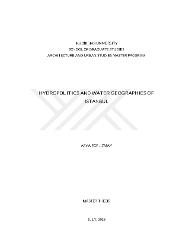| dc.contributor.advisor | Erek, Ayşe | |
| dc.contributor.advisor | Bozdoğan, Sibel | |
| dc.contributor.author | Uzmay, Asya Ece | |
| dc.date.accessioned | 2023-10-17T20:46:19Z | |
| dc.date.available | 2023-10-17T20:46:19Z | |
| dc.date.issued | 2019 | |
| dc.identifier.uri | https://tez.yok.gov.tr/UlusalTezMerkezi/TezGoster?key=tqUiYt63sTQLTpozMJ92QuOM3BtpW-HvgbfAOjh1PdHnuSi4aICipGD34d-iFl-n | |
| dc.identifier.uri | https://hdl.handle.net/20.500.12469/4469 | |
| dc.description.abstract | Bu tez, şehrin hinterlandıyla olan ve tarihsel süreçlerle değişen ilişkisini araştırarak, modernleşme sonrası İstanbul ve hinterlandının değişen su ilişkilerine bakmaktadır. Kentin ve doğasının iki ayrı kavram değil, aksine birbiriyle çok yakından ilişkili, hiyerarşisi olmayan, tarihsel süreçlerin sonucu olduğu fikri üzerinden yola çıkar. Suyun, İstanbul'un kuruluşundan beri şehrin şekillenmesinde önemli bir rolü vardır. Yakınlarda su kaynağı bulunmaması nedeniyle, artan nüfusun ihtiyaçlarına cevap vermek amacıyla İstanbul kilometrelerce uzaktan su getirmek durumunda kalmıştır. Modernleşmeyle birlikte, batı şehirleriyle eş zamanlı olarak, tarihi su yolları terkedilmeye başlanmış, merkezi yapıya sahip olan modern sistemler benimsenmiştir. Bu sistemlerin uygulanması için kurulan iki yabancı şirket (Compagnie des Eaux de Constantinople ve Compagnie des Eaux de Scutari et Kadikeui) Cumhuriyet'in kuruluşundan kısa bir süre milletleştirilmiş, şehrin su ihtiyacın karşılamak gibi önemli bir görev İstanbul Belediyesi'ne verilmiştir. İstanbul'un su altyapısında modernleşme, dönem dönem planlamalar yapılsa da, kentin büyümesine ayak uyduramadığı ve de ekonomik olarak altından kalkılamadığı için gelişigüzel ve hibrit bir yapıya sahiptir. Özellikle devletin altyapı yerine sanayiye yatırım yapma tercihi kentsel altyapının ikinci plana atılmasına sebep olmuştur. Yetişilemeyen bölgelerde yer altı suları kullanılmış, terkedilen eski su yolları kullanılmaya devam edilmiş, bir yandan da merkezi sistemde iyileştirmeler yapılmaya çalışılmış. Bu parçalı resim İstanbul'da su altyapısının batılı modernleşme kalıplarının dışında bir süreçten geçtiğini gösterir. Tezde anlatılan bu süreçler 1970'te Sağmalcılar ve çevresinde gerçekleşen kolera salgınıyla birleşir. Bu salgın pis sulardan bulaşmakta ve hijyen eksikliğini göstermektedir. Tezde kentte yaşanan eşitsizliklerin Sağmalcılar'da kendini gösterme biçimleri incelenmektedir. Bu süreç o zamana kadarki su politikaları üzerinden tartışmaya açılır. | en_US |
| dc.description.abstract | This thesis dealt with the changing historical relations of İstanbul and its hinterland with modernization via looking through historical processes. It is based on the idea that the city and the nature are not two separate nations, contrary they are too relational and non-hierarchical concepts. Water has had an important role since the establishment of the city. There was no nearer water source in İstanbul therefore İstanbul was providing from kilometres away in order to answer the needs of increasing population. After modernization, historical water ways were abandoned, centralized modernist water distribution systems were invested on as simultaneously with western cities. With the establishment of Republic, two foreign companies that were distributing water to İstanbul (Compagnie des Eaux de Constantinople ve Compagnie des Eaux de Scutari et Kadikeui, were nationalized. After that, providing water to İstanbul became the duty of the İstanbul Municipality. Modernization of İstanbul's water infrastructure is haphazard and hybrid although several plans were made, since it was hard to follow the rapid and unplanned urbanization of the city with the limited economical resources. Industrial investments were preferred over infrastructural investments therefore infrastructural investments became of secondary importance. In unplanned areas, subterranean water sources were used in order to subsidize networked water, abandoned water sources were used. On the other hand reforms in the central water network was made. This fragmented picture of infrastructure of İstanbul, display the impermanent modernization pattern of İstanbul contrary to western modernization myths. The abovementioned processes are the subject of this thesis. These processes cross with the 1970 cholera epidemic in Sağmalcılar. Cholera epidemic infects via contaminated water sources and display the unhygienic conditions I some parts of the city. This thesis looks for the manifestations of inequalities in the city and it is discussed through hydropolitics in late Ottoman and Early Republic. | en_US |
| dc.language.iso | eng | en_US |
| dc.publisher | Kadir Has Üniversitesi | en_US |
| dc.rights | info:eu-repo/semantics/openAccess | en_US |
| dc.subject | Coğrafya | en_US |
| dc.subject | Geography ; Kamu Yönetimi | en_US |
| dc.title | Hydropolitics and water geographies of Istanbul | en_US |
| dc.title.alternative | İstanbul'un su politikaları ve su coğrafyaları | en_US |
| dc.type | masterThesis | en_US |
| dc.identifier.startpage | 1 | en_US |
| dc.identifier.endpage | 101 | en_US |
| dc.department | Enstitüler, Lisansüstü Eğitim Enstitüsü | en_US |
| dc.institutionauthor | Uzmay, Asya Ece | |
| dc.relation.publicationcategory | Tez | en_US |
| dc.identifier.yoktezid | 695886 | en_US |
| dc.khas | 20231017-Tez | rn_US |
















